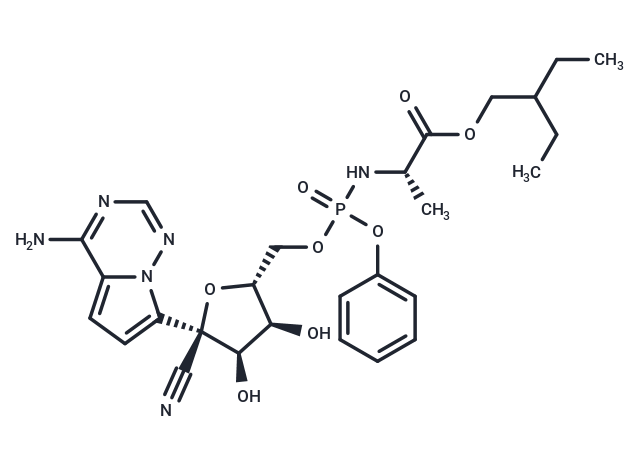Powder: -20°C for 3 years | In solvent: -80°C for 1 year
Remdesivir [1809249-37-3]
Cat# T7766-1mL
Size : 1mL
Brand : TargetMol
Remdesivir
Catalog No. T7766 CAS 1809249-37-3
Synonyms: GS-5734
Remdesivir (GS-5734) is a nucleoside analog, a broad-spectrum antiviral compound that exerts its activity by inhibiting the RNA-dependent RNA polymerase of viruses. Remdesivir is active against Ebola, SARS, and MERS viruses, and is potentially therapeutic against COVID-19.
All TargetMol products are for research or drug registration purposes only and cannot be used for human consumption. We do not provide products or services to individuals. Please comply with the intended use and do not use TargetMol products for any other purpose in violation of laws and regulations.

Remdesivir, CAS 1809249-37-3
| Description | Remdesivir (GS-5734) is a nucleoside analog, a broad-spectrum antiviral compound that exerts its activity by inhibiting the RNA-dependent RNA polymerase of viruses. Remdesivir is active against Ebola, SARS, and MERS viruses, and is potentially therapeutic against COVID-19. |
| Targets&IC50 | SARS-CoV:74 nM (EC50) , MERS-CoV:74 nM (EC50) |
| In vitro | METHODS: Mouse hepatitis virus (MHV)-infected DBT cells were incubated with Remdesivir (0.01-1 µM) for 24 h, and the supernatant was analyzed for viral titer by plaque assay. RESULTS: Remdesivir effectively inhibited MHV with an EC50 of 0.03 µM. [1] METHODS: 2019-nCoV-infected Vero E6 cells were treated with Remdesivir (0-400 µM) for 48 h. Viral yield in cell supernatants was detected using qRT-PCR. RESULTS: Remdesivir effectively blocked viral infection at low micromolar concentrations and showed high SI (EC50 = 0.77 μM; CC50 > 100 μM; SI > 129.87). [2] |
| In vivo | METHODS: To assay antiviral activity in vivo, Remdesivir (25 mg/kg, 12% sulfobutylether-β-cyclodextrin sodium salt in water (with HCl/NaOH) at pH 5.0) was injected subcutaneously into MERS-CoV-infected Ces1c-/- hDPP4 mice twice daily. RESULTS: Prophylactic Remdesivir reduced MERS-CoV replication and disease. [3] METHODS: To assay antiviral activity in vivo, Remdesivir (25 mg/kg once daily, administered three times) and Loratadine (10 mg/kg once daily, administered four times) were administered intraperitoneally to 501Y.V2 SARS-CoV-2 infected BALB/c mice. RESULTS: The combination of Remdesivir and the antihistamine Loratadine reduced SARS-CoV-2 replication and inflammation and protected against lung injury. [4] |
| Synonyms | GS-5734 |
| Molecular Weight | 602.58 |
| Formula | C27H35N6O8P |
| CAS No. | 1809249-37-3 |
Storage
Solubility Information
DMSO: 50 mg/mL (82.98 mM)
 References and Literature
References and Literature
1. Agostini ML, et al. Coronavirus Susceptibility to the Antiviral Remdesivir (GS-5734) Is Mediated by the Viral Polymerase and the Proofreading Exoribonuclease. mBio. 2018 Mar 6;9(2):e00221-18. 2. Wang M, et al. Remdesivir and chloroquine effectively inhibit the recently emerged novel coronavirus (2019-nCoV) in vitro. Cell Res. 2020 Mar;30(3):269-271. 3. Sheahan TP, et al. Comparative therapeutic efficacy of remdesivir and combination lopinavir, ritonavir, and interferon beta against MERS-CoV. Nat Commun. 2020 Jan 10;11(1):222. 4. Wu ML, et al. Combinational benefit of antihistamines and remdesivir for reducing SARS-CoV-2 replication and alleviating inflammation-induced lung injury in mice. Zool Res. 2022 May 18;43(3):457-468. 5. Li Y, Cao L, Li G, et al. Remdesivir Metabolite GS-441524 Efficiently Inhibits SARS-CoV-2 Infection in Mouse Model[J] . Journal of medicinal chemistry. 2020
 Citations
Citations
1. Williams C G, Jureka A S, Silvas J A, et al. Inhibitors of VPS34 and fatty-acid metabolism suppress SARS-CoV-2 replication. Cell Reports. 2021: 109479. 2. Li, Quanjie, et al Corilagin inhibits SARS-CoV-2 replication by targeting viral RNA-dependent RNA polymerase.. Acta Pharmaceutica Sinica B. (2021). 3. Li Y, Cao L, Li G, et al. Remdesivir Metabolite GS-441524 Efficiently Inhibits SARS-CoV-2 Infection in Mouse Model. Journal of Medicinal Chemistry. 2020 4. Zhao J, Liu Q, Yi D, et al. 5-Iodotubercidin inhibits SARS-CoV-2 RNA synthesis. Antiviral Research. 2022: 105254. 5. Zhao J, Liu Q, Yi D, et al. 5-Iodotubercidin inhibits SARS-CoV-2 RNA synthesis. Antiviral Research. 2022: 105254. 6. Nicholson M W, Huang C Y, Wang J Y, et al. Cardio-and Neurotoxicity of Selected Anti-COVID-19 Drugs. Pharmaceuticals. 2022, 15(6): 765 7. Nguyenla X, Wehri E, Van Dis E, et al. Discovery of SARS-CoV-2 antiviral synergy between remdesivir and approved drugs in human lung cells. Scientific Reports. 2022 Nov 2;12(1):18506. 8. Yousefi M, Lee W S, Chan W O Y, et al.Betacoronaviruses SARS-CoV-2 and HCoV-OC43 Infections in IGROV-1 Cell Line Require Aryl Hydrocarbon Receptor.Emerging Microbes & Infections.2023 (just-accepted): 2256416. 9. Chen Y, Guo Y, Li S, et al.Remdesivir inhibits the progression of glioblastoma by enhancing endoplasmic reticulum stress.Biomedicine & Pharmacotherapy.2023, 157: 114037. 10. Leng L, Xu Z, Hong B, et al.Cepharanthine analogs mining and genomes of Stephania accelerate anti-coronavirus drug discovery.Nature Communications.2024, 15(1): 1537.


